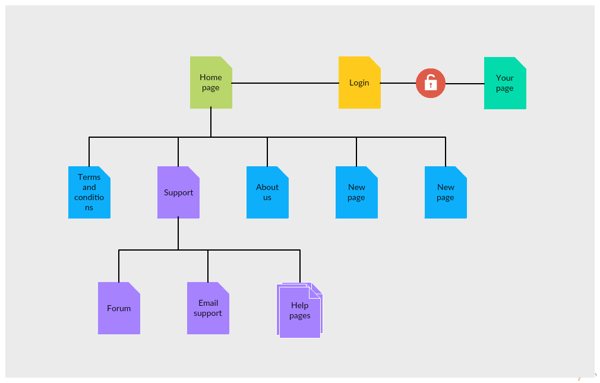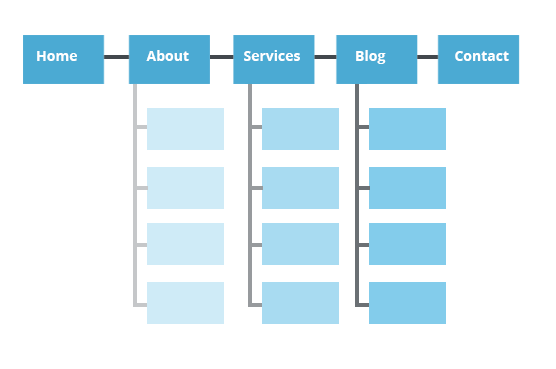How to Create a Sitemap for Inbound Success
Any effective website is going to need a carefully-planned sitemap for it to be a success. Planning out a sitemap is vital when it comes to excelling in Inbound Marketing, as it’s a fantastic tool for planning, organising, building and brainstorming any large website project. Here’s how to create a sitemap for Inbound success.

The steps you should follow to create a sitemap for Inbound success include:
- Set and outline your goals
- Audit the current website
- Map out the sitemap architecture
- Start the sitemap
- Conduct user testing
Some Important Tips to Begin With...
The sitemap you create should be a list of every page in your website organised in a hierarchical fashion. Keeping in line with the GDD way of website designs, the initial sitemap won’t and shouldn’t list each and every single page. Instead, during a strategy or planning phase, your team should brainstorm ideas on how to further improve the website.
Here, you'll know at a glance where future content and pages will fit into the website as time passes by. At first, only the most important pages that will have the highest impact on users will be live.
The key to Inbound success is by laying down a solid foundational sitemap, so ensure that you’re designing a sitemap with your key buyer personas and ideal customer in mind. By having strong knowledge about them, you’ll be in a better position to conduct research and add the impact pages to the sitemap which they’ll interact positively with. Without that relevant research, you won’t know which pages will contribute towards Inbound success or be detrimental.
Set and Outline Your Goals
The only way an ordinary sitemap can be separated from a successful one is if you have outlined the goals and what you want your website to achieve. This is a vital first step when it comes to creating a sitemap for Inbound success.
You need to think about the information you want to convey to the users visiting your website and the actions you want them to take. They’re going to have pain points - that’s why they’re on your website so when you’re setting the goals, ask yourself what the users will actually achieve when they use your website.
Once you have set the goals of your website, you can start to plan out the rest of the sitemap and which pages need to be on the website right away.
*Side Note
When you’re doing sitemap research, you’re probably going to come across some other terms too. Information Architecture and Navigation are terms which are also often used, so we’ll clear that up now as well to avoid confusion.
Information Architecture: Defines the overarching structure and relationship between all the areas of a website and informs the sitemap.
Sitemap: Lists all of the labelled pages in its entirety and shows the structure, hierarchy, goals of each page as well as the functionality which is on the page.
Navigation: Guides users via all of the links to every area of the website.
Despite that, all of the terms are usually used to describe a sitemap.
Audit the Current Website
Once the goal has been set, you can’t dive in right away in case you make even more errors. Next, it’s important that you run an audit of your existing website so that you know exactly what’s working on the site and what needs to be changed when you’re at the exciting step of building the brand new one.
An in-depth audit helps to determine the value of every current page on your website and how they’re built. It also helps you to analyse how each page is performing right now and how important they are to the conversion funnel. As you can imagine, this is fairly essential as it gives you a better idea of which pages are the most successful right now - so they’ll need to be featured in the sitemap.
An audit also gives you a better idea of where your web pages are linking to, so you know which pages drive the most traffic as well as which targeted keywords are improving your search rankings and which aren’t. This lets you make informed decisions on how and where the pages should live on your website.
Map out the Sitemap Architecture
Once you’ve finished the auditing website and analysed the results from that, you’ll need to map out your website’s architecture. This is where all of that research is key, as you’ll be prioritising the pages that should feature on the website as you’ll have a better idea of which pages actually have had some value and which ones have never had much success.
The architecture of your website defines the correlation between every single area of the pages on your website. It takes into consideration how your users are going to navigate from one page to another. Make sure you always keep the goal of your website and the pain points of your persona in mind - as the architecture of the sitemap will revolve around what the most effective and efficient way is for a visitor to achieve that goal.
To make it simpler, just think of yourself as the user for a while and determine what makes the most logical sense as they click through your website - even if it’s in reverse order. The key to an effective Inbound sitemap is that it should be easy for a user to navigate throughout your website and quickly access all of the pages they need to. The more confusing and less-optimised your sitemap is, the less Inbound success you’ll have.
Start the Sitemap
Once all of the above is complete, it’s time to put that knowledge into action and actually create the sitemap. Although there are several ways in which a sitemap can be created, such as diagrams, spreadsheets and other visual mapping tools, you need to first layout the sitemap of your current website.
This is so that you can review best practices as well as seeing what your competitors are doing so that your new sitemap can be much more successful in solving pain points and achieving your own goals.
The first important step is to outline the navigation items and make sure they’re listed first. Considering this is a sitemap for Inbound success, it’s pivotal that you’re taking SEO into account. To do this, consider the name of each navigation item and where it should be placed as they’re going to be in an important place on the homepage. As you’re listing out each page, always keep the user experience in mind throughout the website.
 Site Architecture. Source: Creately
Site Architecture. Source: Creately
The pages and the content featured on those pages all need to be keyword optimised and serve a useful purpose.
The next part of your Inbound-driven sitemap should focus on the secondary pages that you’ll map out. These are the pages that go under the main navigation so it’s important to consider the content so you avoid duplicating content or mapping out pages that can be considered useless. These pages are also vital, so optimisation is key as the content here focuses on specific information. The navigation page content, on the other hand, is generally information that overlooks the subpages.
Believe it or not, you’ll need to focus on the footer of your website as well. While it’s not solely something for Inbound, it’s still important to consider. This is because visitors usually scroll down to the footer to search for contact information or details about the company. Without a footer that’s easy to find, information might not be found quickly and you could lose those all-important leads.
Creating and implementing a sitemap does sound like it’ll take a while, but it’s still important that you don’t skim over any page when doing your research to decide what does and doesn’t need to be included. Considering your website is your number one salesperson, you can’t afford to dent your chances of achieving your goals by not thinking about all of the pages.
How Else You Can Set Your Sitemap up for Inbound Success
- Submit your sitemap to Google Search Console and Bing Webmaster Tools - A common issue for any website is how to get it on search engine websites like Google and Bing. By doing this, it helps search engines to better crawl and categorise the website so it can be publicly viewed. That’s why it’s beneficial to have a sitemap file link in the footer, as it can help the search engine crawl to quickly discover and continue crawling through your website effectively.
- Focus on SEO - By putting SEO and keyword research at the forefront of your sitemap planning, you’ll be able to use keywords that will help you rank towards the top of search engines like Google.
- Conduct Regular Testing - Once your sitemap is completed, it shouldn’t be left like that. Instead, conduct regular testing - such as A/B testing - so that you know what is and isn’t working on your website and implement the changes down the line.
- Consider Using a Principle Like GDD - To do the above, utilising Growth-Driven Design is the best way to do that and make those continued changes. This can’t be accomplished with traditional methods and by using GDD, you can continue analysing user data and make effective changes all the time to ensure the sitemap and the website as a whole is having Inbound success.
What an Inbound-Focused Marketing Sitemap Will Accomplish
The brilliant thing about a marketing sitemap using a principle like Growth-Driven Design is that the sitemap allows you to visualise the content of your website and then build it all before it goes live. If an Inbound-focused sitemap is created in a timely fashion - and done well - it should accomplish the following:
- Establish design specifications that will be followed by the rest of the design and development team at an early stage.
- Empowers your content team to create content that’s full of value and focuses on conversion.
- It can help streamline keyword research and other on-page SEO tasks.
- You’ll be more successful on search engines like Google and Bing.
- You’ll know exactly which changes to make based on user behaviour to help solve pain points and achieve goals.
- By making those changes you can convert even more leads by targeting the persona directly.
Find out how else you can Make your Website a Success With GDD
Creating a sitemap is only one of the important factors needed to make your website a big success. Using Growth-Driven Design, you’ll be setting your website up for plenty of success - but there’s so much more you’ll need to know about the ‘new’ principle before you can dive in.
If you fancy learning more about GDD as well as finding out some useful tips and what’s involved in the process, then you can check out the helpful guide we’ve created. Simply click on the link below to grab your free copy to gain a deeper understanding of GDD.
Real Growth. Real Impact.
AI and HubSpot: Transformation... If Enabled Properly
'Should I use HubSpot?' 32 fundamental reasons why you should
Interviewing an AI version of HubSpot's founder was weird
Avidly named HubSpot EMEA and APAC Partner of the Year
Transforming content strategies: Avidly earns HubSpot Content Experience Accreditation
21 cost-effective marketing campaigns you can create right now
See why enterprises choose Avidly
Let’s build your HubSpot success story
Compelling final call to action - with accompanying link to Contact page








